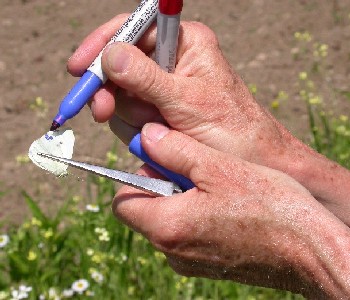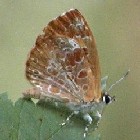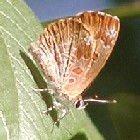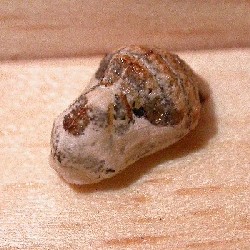
June 9, 2005. Renee found the first Harvester of the year, posing
on the same plant, then sporadically flying off to land on one of us.
 
He was quite content to sit on Renee's hand, despite her moving it
around to try to catch the light or to give me a better angle for photographing
it. Later that day she discovered two more butterflies for a total of three.

June 10. Renee found three harvesters in different locations
from yesterday, including one ovipositing and one on the
Elm
Leaf. One also seen on the Elm Leaf on 6/11 and 6/21 (when this
photo was taken).


June 23. Renee discovered some caterpillars, and I collected
three, putting them in two containers. Note that the one on top is hairless
(and two of the caterpillars were like this). I tried to figure out what
was going on with it, but it wasn't until June 28 that, reading an article
on Harvester caterpillars, I saw a photo of one of these, which were identified
as the larva of syrphid flies (Syrphus spp.).
Between June 24 and July 11, Renee was regularly patrolling the
the area, and saw almost no Harvesters.
June 25. The first container, thought to contain two caterpillars,
ran out of aphids today, and so I went on a search. I figured I'd bring
two sticks with aphids to allow each to have its own container. When I
returned to transfer them, I discovered there were four caterpillars, which
I divided into the two containers.
June 28. I read about syrphid flies and disposed of those caterpillars.
I had enough to do because caterpillars kept appearing out of the aphids,
and I had enough to do! Rather than go blow by blow, with each date, the
following chart should be somewhat self explanatory.

The letter designations were simply for me to keep track of various
individuals. C4, which pupated in the longest time, turned out to be deformed
and never was able to unfurl its wings.
 |
|
This year, Renee and I decided we would try to keep track of individual
butterflies, and tried to figure out a way to do this easily. We did some
research on how butterflies had been marked in other places, and found
that people had used a Sharpie marker.
We didn't want to experiment on Harvesters - there aren't that
many of them around - so we practiced with Cabbage Whites. We decided only
to mark butterflies we raised, since they are lethargic when they eclose,
and we figured we could do it easily without damaging them. We had it down
to a science. Capture, gently hold in forceps, and mark. Right. |
July 6. Caterpillar C1 eclosed. I called Renee and prepared:
I laid out paper towels, forceps, Sharpie. Very surgical looking. Renee
arrived. We gently removed C1 from the glass jar, and forceped it. It all
went downhill from there. Cabbage Whites have big wings that are thicker
than Harvesters. Poor C1 struggled till its scales started falling off.
I put it back in the jar, and immediately drove it over to the capture
site and released it. C2 eclosed shortly thereafter and I released it without
even making an effort. I like to think I'm a hard-nosed naturalist, but
I admit to getting emotional.
July 7. C3 eclosed last night, so I girded my loins for another
attempt at marking. This time I just put the Sharpie in the container and
poked at the wings. Not fancy, but it worked:
    
And I marked and photographed all the rest of the butterflied I released.
Then we started looking at all the Harvesters we saw.
    
Lot of good it did us. We never saw a single marked butterfly.
July 13. Renee saw three worn butterflies.
July 15. Renee saw a butterfly ovipositing.
August 7. Renee saw six butterflies
August 17. Renee saw 12 butterflies, one eclosed chrysalis,
and one caterpillar.
August 28. Renee and Marj saw nine butterflies (including one
ovipositing),
plus at least a dozen caterpillars. Marj collects some.
   
And now we wait. I think there are four caterpillars, but there are
always more than I think.
 |
|
September 5. Yesterday I ran out of aphids - completely. I was
carefully going over the branches and leaves of the two sticks I collected
on August 28 and discovered two pupae and I didn't even know there were
still caterpillars. After a week, the leaves tend to shrivel, and I had
been picking off these leaves as they died. There were only two or three
leaves left, and these were pretty shriveled too, so they had apparently
hidden in the folds of the leaves.
This gave me a total of 6 pupae, but I still had caterpillars so I went
to collect more aphids, and when I went over the old branches carefully
I discovered I had five more caterpillars! Transferring them is always
a challenge because they don't like being disturbed. |
 |
|
On the left, a young larva appears to be shedding its skin. On the
right, three caterpillars in different stages line up to eat. |
|
 |
 |
|
September 8. How about this? Except I have to back
up a couple of days. When I brought in the new aphids, I chose a branch
with small aphids, hoping that it wouldn't hide any more caterpillars,
since my experience with large aphids usually means a lot more caterpillars.
I wanted a relatively controlled group this time. The caterpillars kind
of lined up beside them as you can see by the photo under September 5.
But three of them just couldn't get the hang of it, and by September 6,
they had all crawled out onto leaves. They definitely didn't look big enough
to pupate, but two days later, pupate they did. The pupa on the left is
A1, the first caterpillars to pupate on September 1. The one on the right
pupated today. Below I've tried to show actual size (size in millimeters).
We had a similar experience with small caterpillars in 2003. |

 |
|
September 9. Well, that small aphid branch really
has turned up some surprises. Yesterday one of the two remaining caterpillars
was fat and happy eating aphids. I couldn't find the other (the little
one that was shedding skin on 9/5). This morning I couldn't find either,
so I searched everywhere and found a small pupa on the paper towel at the
bottom of the jar (left). |
|
 |
 |
|
I found a normal sized pupa under the table (above right).
I pried it off and for the first time could see what the bottom looks like
(click if you want to see a close-up photo). I also found an old pupa shell
near the live chrysalis. On April 19, 2004
I discovered a very worn butterfly on the porch, which must have been from
this pupa. It was very papery and soft. |
|
 |
|

